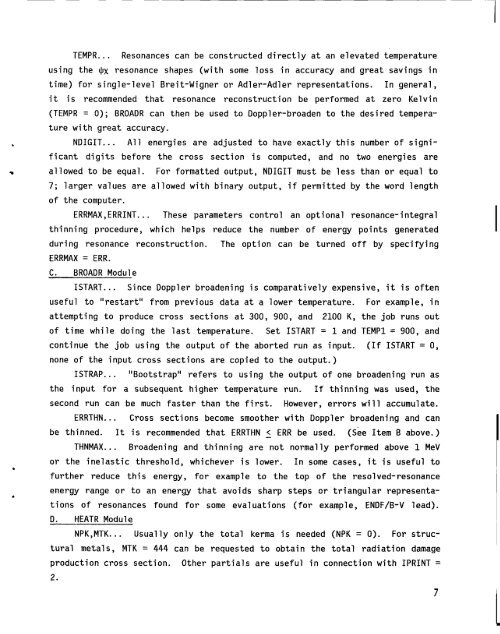The NJOY Nuclear Data Processing System, Volume 1:User's Manual
The NJOY Nuclear Data Processing System, Volume 1:User's Manual
The NJOY Nuclear Data Processing System, Volume 1:User's Manual
Create successful ePaper yourself
Turn your PDF publications into a flip-book with our unique Google optimized e-Paper software.
,<br />
TEMPR... Resonances can be constructed directly at an elevated temperature<br />
using the $X resonance shapes (with some loss in accuracy and great savings in<br />
time) for single-level Breit-Wigner or Adler-Adler representations. In general,<br />
it is recommended that resonance reconstruction be performed at zero Kelvin<br />
(TEMPR = O); BROADR can then be used to Doppler-broaden to the desired tempera-<br />
ture with great accuracy.<br />
NDIGIT... All energies are adjusted to have exactly this number of signi-<br />
ficant digits before the cross section is computed, and no two energies are<br />
* allowed to be equal. For formatted output, NDIGIT must be less than or equal to<br />
7; larger values are allowed with binary output, if permitted by the word length<br />
of the computer.<br />
ERRMAX,ERRINT. .. <strong>The</strong>se parameters control an optional resonance-integral<br />
thinning procedure, which helps reduce the number of energy points generated<br />
during resonance reconstruction. <strong>The</strong> option can be turned off by specifying<br />
ERRMAX = ERR.<br />
c. BROADR Module<br />
ISTART... Since Doppler broadening is comparatively expensive, it is often<br />
useful to “restart” from previous data at a lower temperature. For example, in<br />
attempting to produce cross sections at 300, 900, and 2100 K, the job runs out<br />
of time while doing the last temperature. Set ISTART = 1 and TEMP1 = 900, and<br />
continue the job using the output of the aborted run as input. (If ISTART = O,<br />
none of the input cross sections are copied to the output.)<br />
ISTRAP... “Bootstrap” refers to using the output of one broadening run as<br />
the input for a subsequent higher temperature run. If thinning was used, the<br />
second run can be much faster than the first. However, errors will accumulate.<br />
ERRTHN... Cross sections become smoother with Doppler broadening and can<br />
be thinned. It is recommended that ERRTHN ~ ERR be used. (See Item B above.)<br />
THNMAX. .. Broadening and thinning are not normally performed above 1 MeV<br />
or the inelastic threshold, whichever is lower. In some cases, it is useful to<br />
further reduce this energy, for example to the top of the resolved-resonance<br />
energy range or to an energy that avoids sharp steps or triangular representa-<br />
tions of resonances found for some evaluations (for example, ENDF/B-V lead).<br />
D. HEATR Module<br />
NPK,MTK. .. Usually only the total kerma is needed (NPK = O). For struc-<br />
tural metals, MTK = 444 can be requested to obtain the total radiation damage<br />
production cross section. Other partials are useful in connection with IPRINT=<br />
2.<br />
7
















